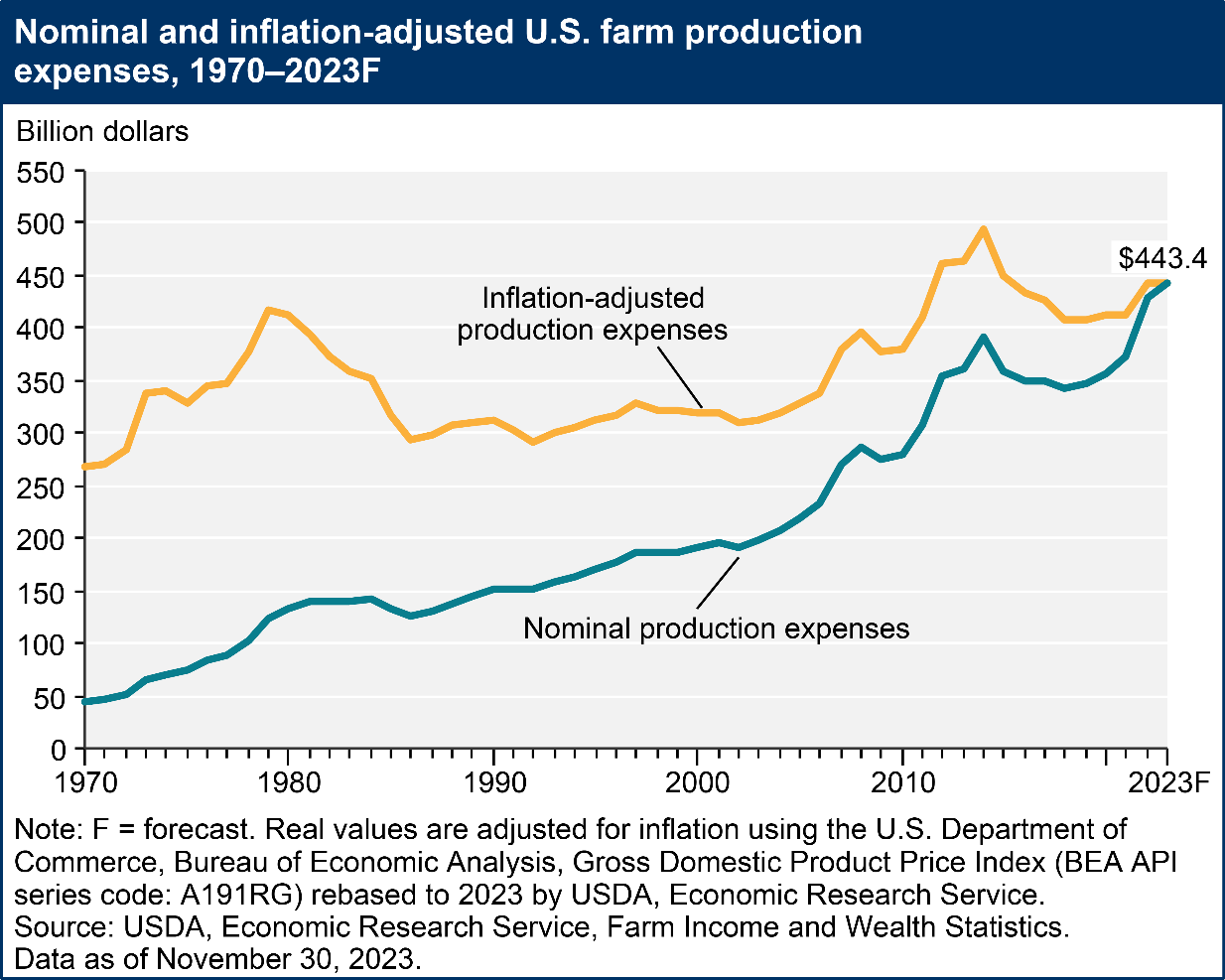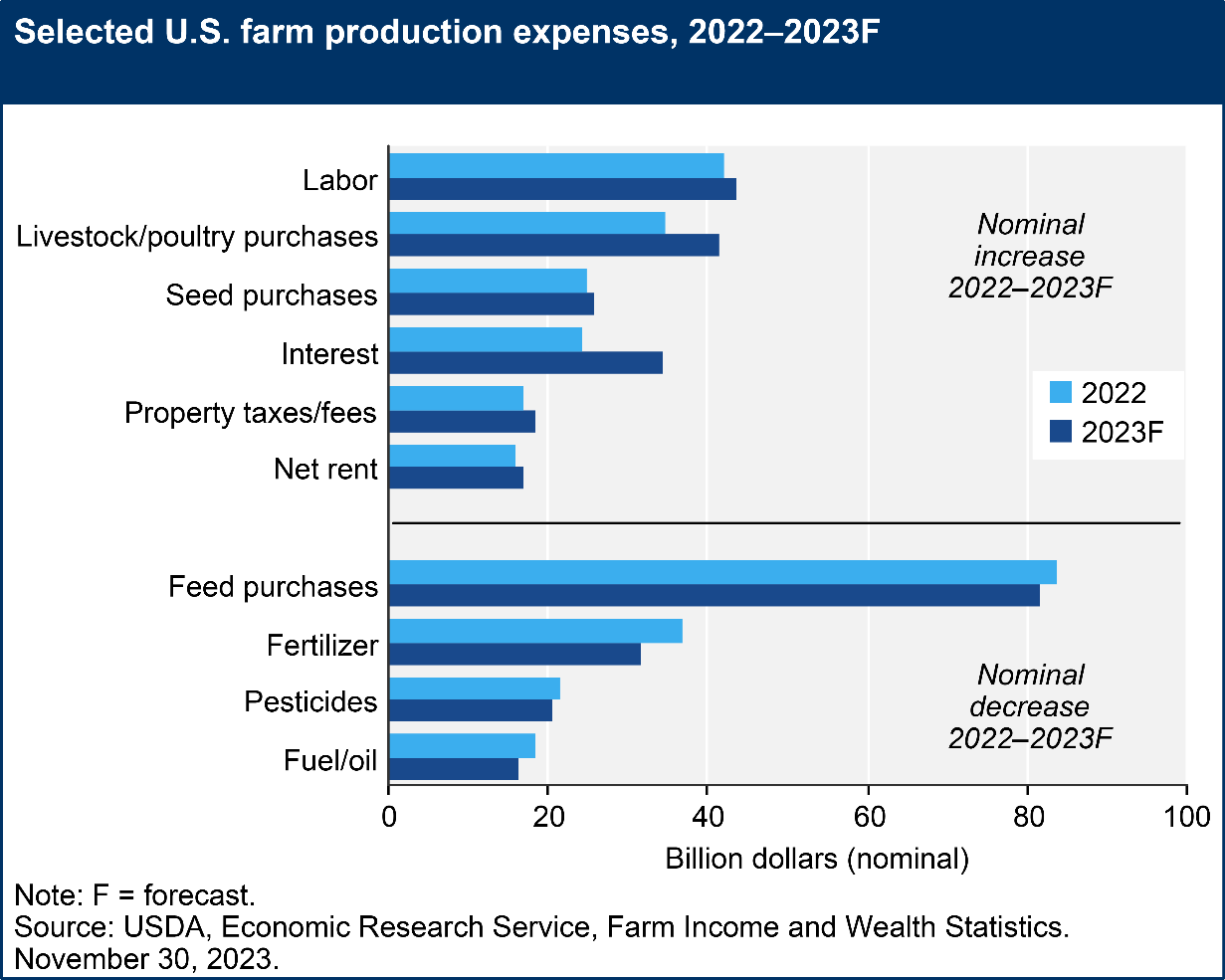Main Takeaways
- The trend of increasing farm input expenses continued in 2023 but, when adjusted for inflation, remains below the record highs seen in 2014.
- Reductions in farm-interest expenses and reductions in fertilizer expenses are two of the most notable changes in 2023.
- Looking forward to 2024, total production expenses are forecast to decline slightly with interest, fertilizer, and pesticide input categories expected to be the biggest movers.
Inputs and Production Expenditures
Amidst the unprecedented challenges posed by the COVID-19 pandemic, the agricultural landscape witnessed a discernible and sharp escalation in input prices across all major farm expense categories. This event set forth a trend of consistently increasing overall U.S. farm production expenses, a trajectory that persisted unabated into 2023. This progression materialized as a significant increase in total farm expenses, culminating in a nominal increase of $14.9 billion, equivalent to a 3.5% upswing in total farm expenses. This equates to a reported $443.4 billion in total farm expenses in Fall 2023 (Figure 1). This increase reflects an inflation-adjusted uptick of nearly $36 billion since the onset of economic challenges induced by the pandemic in 2020.

Beyond the immediate view of pandemic-induced disruptions, the pronounced elevation in farm production expenses over the last 3 years can be attributed to a mix of factors, extending beyond the realms of domestic concerns. Major global economic events, such as the Russian invasion of Ukraine and other geopolitical factors, have played a pivotal role in shaping the intricate economic landscape of the agricultural economy. Although global disruptions and conflicts have driven expenses higher in recent years, it is worth noting that, when adjusted for inflation, forecast production expenses in 2023 remain well below the record highs seen in 2014.
Notable Input Expense Changes in 2023
The U.S. Department of Agriculture Economic Research Service tracked significant farm production expense fluctuations in the categories of interest and fertilizer in 2023. The farm production expense category that saw the largest increase in 2023 was interest on borrowed funds. To combat high inflation, the Federal Reserve was forced to increase the federal funds target rate to between 5.25% and 5.50%. Although this measure has begun to be effective in controlling inflation, its effect on farm lending expenses has been significant. Since 2022, nominal interest expenses are forecast to increase by $10.3 billion in 2023 (42.9%; Figure 2). Despite current interest rates exceeding those observed by consumers over the past decade, they presently stand at less than half of the rates borne by borrowers during the early 1980s.

Conversely, a noteworthy happening in 2023 is the considerable decline in fertilizer expenses, amounting to $5.2 billion (14.1%). This reduction is primarily attributed to the dip in natural gas prices, a necessary input in the production of anhydrous ammonia and other fertilizer products. Additionally, the emergence of new fertilizer processing facilities coming online over the previous year has contributed substantively to this decline (Paulson et. al., 2023). Lower fertilizer expense in 2023 is a critical cost saving that enabled producers to offset production price increases in other categories within the farm budget.
Outlook for 2024
Looking ahead to 2024, the anticipated shifts in farm production input prices are poised to demonstrate a mixed pattern across farm expense categories. Inputs for major Georgia crops such as fertilizers, pesticides, and interest on operating capital are forecast to decline by 8%–14% in the coming year while fuel, lube, electricity, and other variable costs are forecast to increase by 5%–10% by the USDA Economic Research Service (2023). Furthermore, the same USDA report forecasts a 2% reduction in total crop expenses per acre for the year 2024. However, price changes in expense categories such as interest will be highly dependent on how inflation levels fluctuate and the response of the Federal Reserve as it aims to bring inflation rates back down closer to 2%.
Despite the persistence of production costs rising to elevated levels compared to the pre-pandemic era, the marginal reduction in input prices anticipated for 2024 holds the potential to furnish agricultural producers with a slightly improved farm input budgeting position compared to the previous year.
References
Paulson, N., Zulauf, C., Schnitkey, G., & Baltz, J. (2023, August 1). Fertilizer prices continue year-long decline from 2022 peak. Farmdoc Daily. https://farmdocdaily.illinois.edu/2023/08/fertilizer-prices-continue-year-long-decline-from-2022-peak.html
U.S. Department of Agriculture (USDA). (2023, November 15). Cost-of-production forecasts for major U.S. field crops, 2023f-2024f [Data set]. Retrieved December 8, 2023 from https://www.ers.usda.gov/data-products/commodity-costs-and-returns/
USDA Economic Research Service. (2023, November 30). Farm sector income & finances: Farm sector income forecast. https://www.ers.usda.gov/topics/farm-economy/farm-sector-income-finances/farm-sector-income-forecast/
Status and Revision History
In Review on Jan 19, 2024
Published on Jan 23, 2024


























































